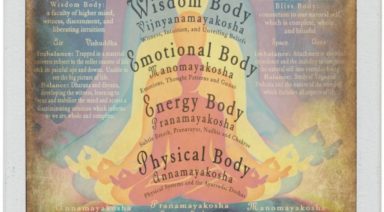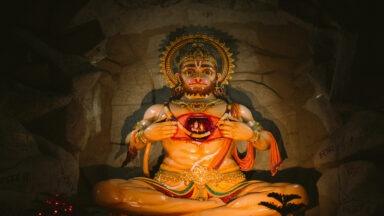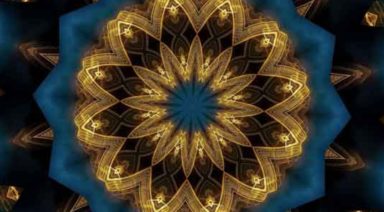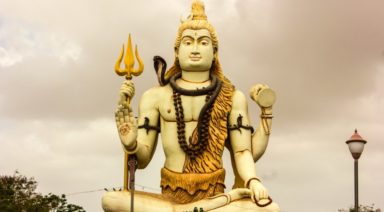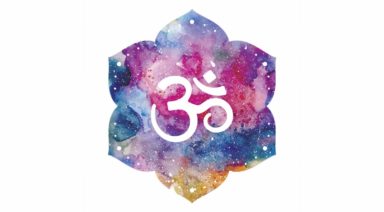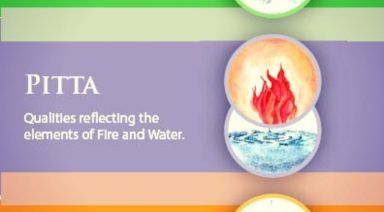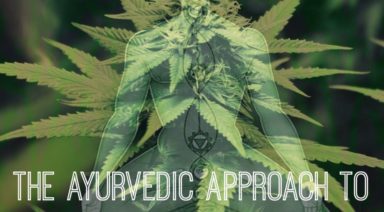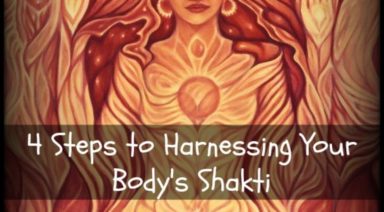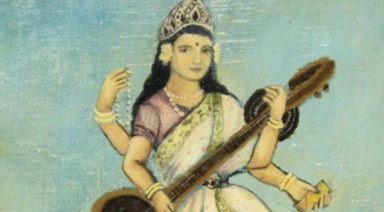What is the Meaning of Om?

“In the beginning was the Word, and the Word was with God, and the Word was God.” It is a particularly human trait to be curious about our origins, and the origins of our universe. How could so much – the diversity of our planet, the vastness of our solar system, the unknown reaches of space – come from nothing? Spiritual traditions from all over the world have grappled with this question, and have recognized the profound role of the Divine Word as the origins, the beginning, of the universe. If at first there was nothing, the very first thing was a sound vibration, and from there, everything sprang into existence, and the material world was born. And Western science is now coming on board as well: quantum physicists have been studying the role of vibration at the root of matter itself.
Nikola Tesla said, “If you want to find the secrets of the universe, think in terms of energy, frequency and vibration.” The very foundations of our Universe, of matter and thought, appear to lie in sound vibration.
And from a yogic perspective, there is a profound connection between speech (the expression of our thoughts) and prana (the life energy carried on the breath). When we speak, we are naming our reality while using the power of the breath to form and express our words. Speech is prana in action. Prana naturally creates sound.
Masaru Emoto, the Japanese researcher who explored the effects of the sound of different words on water, demonstrated the power of our speech and our intention on the matter around us and within us. The potential of sound vibration and intention in creating our reality has been explored in great depth by the ancient yogis, as well as in modern authors like Esther Hicks. Sound healers use chanting and toning to create profound transformation in the body and mind. How to make sense of it all? Perhaps the best place to start is at the beginning.
Perhaps you’ve heard people chanting the sound OM in a yoga class, or listened to a devotional music CD. Or you’ve seen the strange but beautiful symbol on a poster or on someone’s T-shirt. This Sanskrit syllable has become commonplace among yogis and people interested in eastern spirituality, but how many of us really understand its significance, or know how it can support our spiritual practice and growth? This article will explore the meaning, origins, and use of this powerful symbol.
The Cultural and Historical Roots of OM
The syllable OM is an ancient Sanskrit letter first found in the Vedas, originating between 1500 – 1200 BC. A collection of Vedic Sanskrit hymns, they were sung in praise of the Divine. They were not written out at first but were vibrated into existence using human speech. Teachings on the metaphysics of OM were later elaborated on in the Upanishads, ancient Indian mystical texts. Later, the Yoga Sutras of Patanjali categorized the ‘eight limbs of yoga.’ The sixth of these, Dharana, meaning concentration, described various methods of supporting the mind to achieve single-focused attention. Repeating a mantra, and especially this syllable OM, was an important aspect of accomplishing this sixth stage of yoga, or union with the Divine origins. Anne Dyer, sound yoga expert, in an interview with Rodney Yee, explains that Patanjali taught: “Chant Om and you will attain your goal. If nothing else works, just chant Om.”
SreeDevi Bringi, a scholar in eastern religions and yogic studies from Naropa University, states that the main teaching of OM in these ancient texts was to experience non-dual awareness, which is also the goal of all yogic practice.
What is OM? The Primordial Seed Syllable Mantra
Seed, or bija, mantras are single syllable mantras from the Sanskrit language. There are eight primordial shakti seed syllables, including OM. David Frawley, in his book Mantra Yoga and Primal Sound, wrote: “Shakti bija mantras are probably the most important of all mantras, whether for meditation, worship of deities, energizing prana or for healing purposes. They carry the great forces of nature such as the energies of the sun and moon, fire and water, electricity and magnetism, not simply as outer factors but as inner potentials of divine light. They project various aspects of force and radiance for body, mind and consciousness. They hold, resonate, and propel the Kundalini force in specific and transformative ways. Below is a simple table of the main energies (Shaktis) of the Shakti mantras.”
Pranic energy:
- Om pranic energy
- Aim energy of sound
- Hrim solar energy
- Shrim lunar energy
- Krim electric energy
- Klim magnetic energy
- Hum power of fire
- Hlim power to stop
- Strim power to stabilize
- Trim power to transcend
OM, the first of these syllables and carrying immense pranic life force energy, is a mystic syllable, considered the most sacred mantra in Hinduism and Tibetan Buddhism. It appears at the beginning and end of most Sanskrit recitations, prayers, and texts. Om Namah Sivaya is just one of many examples where OM is included within a larger mantra, at the beginning. Considered to represent the primal or primordial sound of the Universe, OM connects us to and carries the Divine in vibrational form, making our prayers and mantras more effective with its increased pranic energy.
What is the Meaning of OM?
Seed mantras like OM are no ordinary words with dictionary definitions. These mantras are more about the vibrational content than the meaning. Frawley again: “Om is the Word of God.” The sound OM is a vibration from which all the manifest universe emanates. Form and creation come from vibration. OM is the most elemental of vibrations. It is the sound of the void. Frawley says: “Om is the prime mantra of the Higher Self or Atman. It attunes us with our true nature. It is the sound of the creator, preserver, and destroyer of the universe, who is also the inner guru and prime teacher. It reflects both the manifest and un-manifest Brahman, sustaining the vibration of being, life, and consciousness in all worlds and all creatures.”
AUM – Creator, Preserver, Destroyer
OM is also sometimes written and pronounced AUM, a prolonging of the individual sounds contained in OM. Each of the three letters, and sounds, corresponds to a different aspect of the divine. The first sound, A, invokes Brahma, the creative aspect. The U sound invokes Vishnu, the preserver. And the M sound, Shiva, represents the destructive aspect of God. So the three sounds in this one syllable remind us of these three aspects of the Divine, without which nothing exists, everything is sustained, and all things dissolve back into the void. After one chants AUM and has taken this journey through the transformation of the cosmos, it is traditional to pause and sit in silence, and experience that creative void, vibrating with that primordial vibration.
OM and Amen
According to Paramahansa Yogananda, author of the classic text Autobiography of a Yogi: “Om or Aum of the Vedas became the sacred word Hum of the Tibetans, Amin of the Moslems, and Amen of the Egyptians, Greeks, Romans, Jews, and Christians.” The syllable has been translated into many different languages, cultures, and religious traditions, but the creative and transformative power of the sound remains the same. In the Bible, the word Amen is connected to the beginning of the creation of the Universe: “These things saith the Amen, the faithful and true witness, the beginning of the creation of God.”
How to Harness the Power of OM
In the yogic tradition, a mantra is a powerful tool to focus and quiet the mind. Try breathing deeply and repeating the sound OM while holding your awareness at the crown of your head, or the third eye point at the brow. Or repeat OM or a mantra that incorporates OM, 108 times with the help of a mala. Called Japa Yoga, this keeps the mind focused and infuses the body, mind, and heart with the qualities of the mantra.
In the Bhakti (devotion) yoga tradition, singing or chanting the names of God opens the heart and brings one to a state of bliss. Om Gam Ganapataye Namah invokes and praises Ganesha, the God of abundance and destroyer of obstacles. By chanting OM before the rest of the mantra, one calls on the power of the word and the primordial origins of sound.
OM is most associated with the 6th (brow point) and 7th (top of the head) chakras. Other syllables are connected to each of the other chakras. Try chanting these as you focus on each chakra or area of the body:
- “LAM”- chakra 1 (root)
- “VAM”- chakra 2 (sacral/navel)
- “RAM”- chakra 3 (solar plexus)
- “YAM”- chakra 4 (heart)
- “HAM”- chakra 5 (throat)
- “OM”- chakra 6 (third eye/brow)
- “OM”- chakra 7 (crown)
Finally, Anne Dyer suggests that in our chanting practice, we progress from chanting OM out loud to whispering the syllable. This is training the mind to focus on the subtle. When we turn down the volume, we have to turn up our attention. When the mind is listening carefully, the mind isn’t busy thinking. In the silence, we might begin to hear the stillness, the sound of the void. Listening deeply to stillness is a profound meditative practice that connects us to the power of creation and the Divine.
In the end, exploring the syllable OM, and the power of sound can remind us to treat our words as sacred, creative, and Divine. What we think and say, we create. We are powerful creators! May our words, through our conscious use of them, regain their transformative power, and may the Divine speak through us as we bring more and more awareness to the vibrations that we create with our thoughts and words. Om Shanti.
Rodney Yee & Colleen Saidman Yee's Favorite Quotes

In honor of our new Yoga Foundations Guide with Rodney Yee and Colleen Saidman Yee, Gaiam TV sat down with them to get their favorite inspirational quotes as we begin the building blocks to a solid yoga for life practice. This guide is excellent for yoga for beginners or anyone looking to revisit the defining elements of a strong asana practice.
This guide includes sun salutations for beginners and beginning yoga routines perfect for anyone new to yoga.
Get a sneak peek of day 3 sun salutations!
Rodney Yee’s Favorite Quotes
Cling to the one thing that matters, hold onto “I am” and let go of all else. ::Nisargatta Maharaj
…and it is this immediate perception, this choiceness awareness that puts an end to sorrow. ::J. Krishnamurti
Feel the motions of tenderness around you, the buoyancy. ::Rumi
Colleen Saidman Yee’s Favorite Quotes
How long, babe, will you search for what’s not lost? ::Bob Dylan
I am an old man and have known a great many troubles, but most of them never happened. ::Mark Twain
The fruit of silence is prayer. The fruit of prayer is faith. The fruit of faith is love. The fruit of love is service. The fruit of service is peace. ::Mother Teresa
Yoga Foundations with Rodney Yee & Colleen Saidman Yee
Yoga guides — they’re not just for beginners anymore. That’s why Gaiam TV partnered with yoga pioneers Rodney Yee and Colleen Saidman Yee. Over the last 15 years, they’ve cultivated the best approach to foundational yoga.
Watch the video below, and sign up for the guide.




